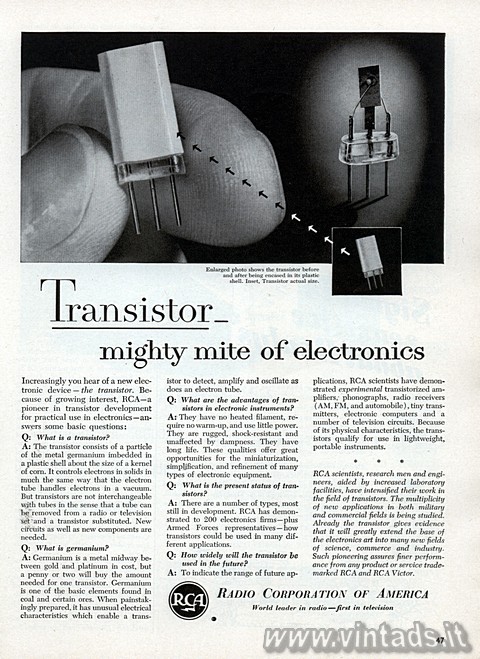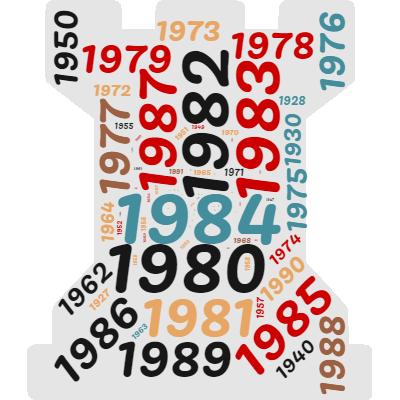Transistor – mighty mite of electronics

Gradimento: 



 (0 voti)
(0 voti)




 (0 voti)
(0 voti)
Per scaricare questo contenuto devi fare login o registrarti
Commenti: Non è presente alcun commento
Effettua il login per inserire un nuovo commento
Titolo: Transistor – mighty mite of electronics
Dimensione file: 2,2 MB (2420x3320 pixel)
Tipo del contenuto: pagina di rivista o giornale
Fonte pubblicazione: Scientific American
Data della fonte: April 1953
Linguaggio: en (English)
Marca del contenuto: Rca
Caricato da: Maverich il 10-05-2020
Testo originale: Transistor – mighty mite of electronics
(Enlarged photo shows the transistor before and after being encased in its plastic shell. Inset, Transistor actual size.)
Increasingly you hear of a new electronic device — the transistor. Because of growing interest, RCA—a pioneer in transistor development for practical use in electronics—answers some basic questions:
Q: What is a transistor?
A: The transistor consists of a particle of the metal germanium imbedded in a plastic shell about the size of a kernel of corn. It controls electrons in solids in much the same way that the electron tube handles electrons in a vacuum. But transistors are not interchangeable with tubes in the sense that a tube can be removed from a radio or television set and a transistor substituted. New circuits as well as new components are needed.
Q: What is germanium?
A: Germanium is a metal midway between gold and platinum in cost, but a penny or two will buy the amount needed for one transistor. Germanium is one of the basic elements found in coal and certain ores. When painstakingly prepared, it has unusual electrical characteristics which enable a transistor to detect, amplify and oscillate as does an electron tube.
Q: What are the advantages of transistors in electronic instruments?
A: They have no heated filament, require no warm-up, and use little power. They are rugged, shock-resistant and unaffected by dampness. They have long life. These qualities offer great opportunities for the miniaturization, simplification, and refinement of many types of electronic equipment.
Q: What is the present status of transistors?
A: There are a number of types, most still in development. RCA has demonstrated to 200 electronics firms—plus Armed Forces representatives — how transistors could be used in many different applications.
Q: How widely will the transistor be used in the future?
A: To indicate the range of future applications, RCA scientists have demonstrated experimental transistorized amplifiers, phonographs, radio receivers (AM, FM, and automobile), tiny transmitters, electronic computers and a number of television circuits. Because of its physical characteristics, the transistors qualify for use in lightweight, portable instruments.
* * *
RCA scientists, research men and engineers, aided by increased laboratory facilities, have intensified their work in the field of transistors. The multiplicity of new applications in both military and commercial fields is being studied. Already the transistor gives evidence that it will greatly extend the base of the electronics art into many new fields of science, commerce and industry. Such pioneering assures finer performance from any product or service trade-marked RCA and RCA Victor.
Radio Corporation of America
World leader in radio—first in television
Tag:
Dimensione file: 2,2 MB (2420x3320 pixel)
Tipo del contenuto: pagina di rivista o giornale
Fonte pubblicazione: Scientific American
Data della fonte: April 1953
Linguaggio: en (English)
Marca del contenuto: Rca

Caricato da: Maverich il 10-05-2020
Testo originale: Transistor – mighty mite of electronics
(Enlarged photo shows the transistor before and after being encased in its plastic shell. Inset, Transistor actual size.)
Increasingly you hear of a new electronic device — the transistor. Because of growing interest, RCA—a pioneer in transistor development for practical use in electronics—answers some basic questions:
Q: What is a transistor?
A: The transistor consists of a particle of the metal germanium imbedded in a plastic shell about the size of a kernel of corn. It controls electrons in solids in much the same way that the electron tube handles electrons in a vacuum. But transistors are not interchangeable with tubes in the sense that a tube can be removed from a radio or television set and a transistor substituted. New circuits as well as new components are needed.
Q: What is germanium?
A: Germanium is a metal midway between gold and platinum in cost, but a penny or two will buy the amount needed for one transistor. Germanium is one of the basic elements found in coal and certain ores. When painstakingly prepared, it has unusual electrical characteristics which enable a transistor to detect, amplify and oscillate as does an electron tube.
Q: What are the advantages of transistors in electronic instruments?
A: They have no heated filament, require no warm-up, and use little power. They are rugged, shock-resistant and unaffected by dampness. They have long life. These qualities offer great opportunities for the miniaturization, simplification, and refinement of many types of electronic equipment.
Q: What is the present status of transistors?
A: There are a number of types, most still in development. RCA has demonstrated to 200 electronics firms—plus Armed Forces representatives — how transistors could be used in many different applications.
Q: How widely will the transistor be used in the future?
A: To indicate the range of future applications, RCA scientists have demonstrated experimental transistorized amplifiers, phonographs, radio receivers (AM, FM, and automobile), tiny transmitters, electronic computers and a number of television circuits. Because of its physical characteristics, the transistors qualify for use in lightweight, portable instruments.
* * *
RCA scientists, research men and engineers, aided by increased laboratory facilities, have intensified their work in the field of transistors. The multiplicity of new applications in both military and commercial fields is being studied. Already the transistor gives evidence that it will greatly extend the base of the electronics art into many new fields of science, commerce and industry. Such pioneering assures finer performance from any product or service trade-marked RCA and RCA Victor.
Radio Corporation of America
World leader in radio—first in television
Tag:
| rca transistor |

